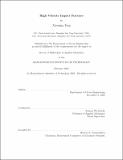| dc.contributor.advisor | Tomasz Wierzbicki. | en_US |
| dc.contributor.author | Teng, Xiaoqing | en_US |
| dc.contributor.other | Massachusetts Institute of Technology. Dept. of Ocean Engineering. | en_US |
| dc.date.accessioned | 2006-03-28T19:52:48Z | |
| dc.date.available | 2006-03-28T19:52:48Z | |
| dc.date.copyright | 2005 | en_US |
| dc.date.issued | 2005 | en_US |
| dc.identifier.uri | http://hdl.handle.net/1721.1/32118 | |
| dc.description | Thesis (Ph. D.)--Massachusetts Institute of Technology, Dept. of Ocean Engineering, 2005. | en_US |
| dc.description | This electronic version was submitted by the student author. The certified thesis is available in the Institute Archives and Special Collections. | en_US |
| dc.description | Includes bibliographical references (p. 315-330). | en_US |
| dc.description.abstract | An in-depth understanding of dynamic ductile fracture is one of the most important steps to improve the survivability of critical structures such as the lost Twin Towers. In the present thesis, the macroscopic fracture modes and the fracture mechanisms of ductile structural components under high velocity impact are investigated numerically and theoretically. Attention is focused on the formation and propagation of through-thickness cracks, which is difficult to experimentally track down using currently available instruments. Studied are three typical and challenging types of impact problems: (i) rigid mass-to beam impact, (ii) the Taylor test, and (iii) dynamic compression tests on an axisymmetric hat specimen. Using an existing finite element code (ABAQUS/Explicit) implemented with the newly developed Bao-Wierzbicki's (BW) fracture criterion, a number of distinct failure modes including fragmentation, shear plugging, tensile tearing in rigid mass-to-beam impact, confined fracture, petalling, and shear cracking in the Taylor test, are successfully recreated for the first time in the open literature. All of the present predictions are in qualitative agreement with experimental observations. | en_US |
| dc.description.abstract | (cont.) This investigation convincingly demonstrates the applicability of the BW's fracture criterion to high velocity impact problems and at the same time provides an insight into deficiencies of existing fracture loci. Besides void growth, the adiabatic shear banding is another basic failure mechanism often encountered in high velocity impact. This failure mechanism and subsequent fracture is studied through numerical simulation of a recently conducted compression test on a hat specimen. The periodical occurrence of hot spots in the propagating adiabatic shear bands is successfully captured. The relation between hot spots and crack formation is revealed. The numerical predictions correlate well with experimental results. An explicit expression controlling through-thickness crack growth is proposed and verified by performing an extensive parametric study in a wide range of input variables. Using this expression, a two-stage analytical model is formulated for shear plugging of a beam/plate impacted by a flat-nosed projectile. Obtained theoretical solutions are compared with experimental results published in the literature showing very good agreement. | en_US |
| dc.description.abstract | (cont.) Three theoretical models for rigid mass-to-beam impact, the single, double, and multiple impact of beam-to-beam are derived from the momentum conservation principle. The obtained closed-form solutions, which are applicable to the axial stretching dominated case, are validated by finite element analysis. | en_US |
| dc.description.statementofresponsibility | by Xiaoqing Teng. | en_US |
| dc.format.extent | 330 p. | en_US |
| dc.format.extent | 18420112 bytes | |
| dc.format.extent | 18453411 bytes | |
| dc.format.mimetype | application/pdf | |
| dc.format.mimetype | application/pdf | |
| dc.language.iso | eng | en_US |
| dc.publisher | Massachusetts Institute of Technology | en_US |
| dc.rights | M.I.T. theses are protected by copyright. They may be viewed from this source for any purpose, but reproduction or distribution in any format is prohibited without written permission. See provided URL for inquiries about permission. | en_US |
| dc.rights.uri | http://dspace.mit.edu/handle/1721.1/7582 | |
| dc.subject | Ocean Engineering. | en_US |
| dc.title | High velocity impact fracture | en_US |
| dc.type | Thesis | en_US |
| dc.description.degree | Ph.D. | en_US |
| dc.contributor.department | Massachusetts Institute of Technology. Department of Ocean Engineering | |
| dc.identifier.oclc | 63791412 | en_US |
